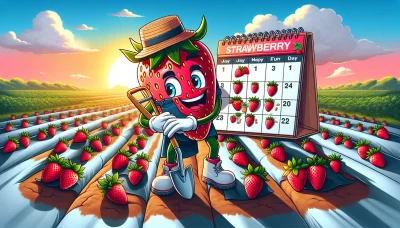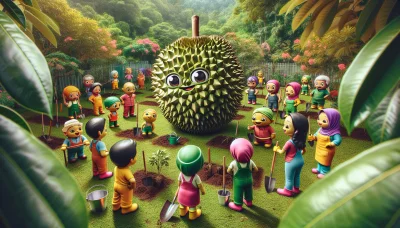Guava how to eat Quiz
Test Your Knowledge
Question of
The Delicious Guava: How to Enjoy This Tropical Fruit
Guava is not only a delicious tropical fruit but also a powerhouse of nutrients. Rich in dietary fiber, vitamins C and A, potassium, and antioxidants, guava offers numerous health benefits, including boosting the immune system and improving heart health. Originating from Central America, guava has spread to various parts of the world, where it is cherished for its unique flavor and health benefits. Whether eaten raw, juiced, or added to dishes, guava is a versatile fruit that can enhance your diet.
Selecting the Perfect Guava
Choosing ripe guavas, whether at your local market or straight from a tree, involves paying close attention to three key aspects: color, texture, and aroma. A ripe guava typically shifts in color from bright green to a light yellow or even a slight pink, depending on the variety. This color change is your first indicator that the guava is reaching its peak ripeness. Next, gently press the fruit with your fingers; a ripe guava will yield slightly under pressure, indicating softness without being overly mushy. Finally, bring the guava close to your nose. A sweet, floral fragrance is a telltale sign of ripeness, promising a deliciously sweet and flavorful fruit. By keeping an eye on these three characteristics, you'll be able to select the perfect guava every time.
Preparing Guava for Consumption
- Washing: Begin by thoroughly rinsing the guava under cold running water. This helps remove any surface dirt and potential pesticides.
- Inspecting: Check the guava for any signs of spoilage or deep bruises. Use a knife to cut away any damaged or bruised areas.
- Drying: Pat the guava dry with a clean towel or let it air dry for a few minutes before proceeding to cut.
- Deciding to Peel or Not: Guava skin is edible, but you may choose to peel it if you find it too rough. If you decide to peel the guava, use a vegetable peeler or a knife, gently removing the skin while preserving as much of the flesh as possible.
- Cutting: You can cut guava into slices, wedges, or cubes depending on your preference. To do this, first slice the guava in half, from the top down.
- Removing the Seeds: Guava seeds are edible but can be hard and unpalatable for some. To remove them, use a spoon to scoop out the seeds from each half if desired. Alternatively, if you've cut your guava into slices, you can cut around the seed core.
- Serving: Once your guava is cut and seeded to your liking, it’s ready to be eaten on its own, added to fruit salads, or used in various recipes!
Creative Ways to Eat Guava
Guava is a tropical fruit known for its unique flavor and numerous health benefits. While delicious on its own, guava can also be incorporated into various meals, adding a sweet and tangy twist that can refresh your palate. From savory dishes to sweet desserts, there are countless ways to enjoy this versatile fruit. Below are some simple guava recipes and serving suggestions to help you incorporate more guava into your diet.
- Guava Smoothie: Blend guava with yogurt and a hint of honey for a refreshing drink.
- Guava BBQ Sauce: Mix guava paste with vinegar, tomato sauce, and spices for a unique BBQ sauce.
- Guava Salad: Add diced guava to salads for a sweet contrast to bitter greens.
- Guava Cheese Tart: Fill a tart shell with cream cheese and top with guava jelly for a quick dessert.
- Guava Chutney: Cook guava with sugar, vinegar, and spices for a tangy condiment.
- Guava and Cheese Sandwich: Pair slices of guava with cheese for a simple and delicious snack.
Growing Your Own Guava Tree
Guava trees are a tropical delight that many gardeners dream of cultivating. These trees thrive in warm climates, typically in hardiness zones 9 through 11, where temperatures rarely dip below 30°F. To start your guava journey, choose a sunny spot with well-draining soil. Guavas are quite adaptable but prefer a pH between 5.5 and 7.0. Regular watering is essential during the first few years to establish the tree, but once mature, guavas are relatively drought-tolerant. Fertilize your guava tree during the growing season to encourage abundant fruit production. Pruning is also important to maintain a manageable shape and size, and to remove any dead or diseased branches. With the right care, your guava tree will reward you with delicious fruit and a beautiful addition to your garden.
Common Pests and Diseases Affecting Guava Trees
| Pests/Diseases | Symptoms to Watch For | Prevention/Treatment Methods |
|---|---|---|
| Guava Fruit Fly | Maggots inside the fruit, causing the fruit to rot | Use fruit fly traps, regularly pick ripe fruits, and maintain cleanliness around the tree |
| Guava Moth | Caterpillars feeding on leaves and fruit, leading to fruit drop | Apply appropriate insecticides and remove affected fruits and foliage |
| Anthracnose | Dark, sunken lesions on fruits and leaves; premature fruit drop | Apply fungicides, prune affected areas, ensure good air circulation |
| Guava Wilt Disease | Wilting and yellowing of leaves, leading to death of the tree | Use disease-free planting material, ensure proper drainage, apply appropriate fungicides |
Harvesting and Storing Guavas
Harvesting guavas at the right time is crucial for ensuring peak ripeness and flavor. The best practice is to wait until the fruit turns light green to yellow and emits a fragrant aroma. Gently squeeze the guava; if it gives slightly under pressure, it's ready to harvest. Use a sharp knife or scissors to cut the fruit from the branch to avoid damaging the tree and the fruit itself.
To store guavas properly and extend their shelf life, keep unripe guavas at room temperature until they fully ripen. Once ripe, guavas can be stored in the refrigerator to slow down the ripening process. Place them in a plastic bag or wrap them in plastic wrap to retain moisture and keep them fresh for up to a week. For longer storage, guavas can be sliced and frozen, ensuring you have delicious fruit available for months.












